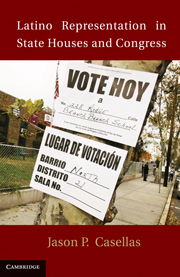Book contents
- Frontmatter
- Contents
- List of Tables
- List of Figures
- Acknowledgments
- Introduction
- 1 Latinos in Legislatures
- 2 The Effects of Population, Turnover, and Term Limits on Latino Representation
- 3 District Composition and the Election of Latino Candidates
- 4 Electing Latinos in Non-Latino Majority Districts
- 5 Voices from Within
- 6 Roll Call Voting Behavior of Latino Legislators
- 7 Conclusion
- Appendix A
- Appendix B
- Appendix C
- Appendix D
- Appendix E
- References
- Index
1 - Latinos in Legislatures
Historical and Theoretical Setting
Published online by Cambridge University Press: 10 January 2011
- Frontmatter
- Contents
- List of Tables
- List of Figures
- Acknowledgments
- Introduction
- 1 Latinos in Legislatures
- 2 The Effects of Population, Turnover, and Term Limits on Latino Representation
- 3 District Composition and the Election of Latino Candidates
- 4 Electing Latinos in Non-Latino Majority Districts
- 5 Voices from Within
- 6 Roll Call Voting Behavior of Latino Legislators
- 7 Conclusion
- Appendix A
- Appendix B
- Appendix C
- Appendix D
- Appendix E
- References
- Index
Summary
Before the Voting Rights Act in 1965, few Latinos served in the U.S. Congress. Before 1912, only one Latino, California Republican Romualdo Pacheco, served in the U.S. House (Vigil 1996). With the exception of New Mexico and Louisiana, no state sent a Latino to Congress between 1912 and 1960 (Lublin 1997). The Congressional Hispanic Caucus began in 1976 through the efforts of Democratic Reps. Herman Badillo (NY), Baltasar Corrada (PR), E. Kika de la Garza (TX), Henry B. González (TX), and Edward Roybal (CA). Compared to the Congressional Black Caucus, the Hispanic caucus is newer and smaller. In 1992 and 1994, African-American representatives numbered thirty-eight whereas Latinos numbered seventeen (Lublin 1997). In 2005, the number of Latinos serving in Congress had increased to twenty-five. More groundbreaking, however, was the election of two Latinos to the U.S. Senate in 2004. By 2008, Sen. Robert Menéndez (D-NJ) was elected to the U.S. Senate, giving Latinos three U.S. senators for the first time in history. Until 2004, no Latino had served in the Senate since New Mexico's Joseph Montoya, who served until 1977.
As shown in Table 1.1 (both parts a and b), the number of Latinos in Congress had increased to twenty-five by 2008. As shown in Table 1.2, the growth of Latinos in Congress is partly a consequence of the national growth in the Latino population.
- Type
- Chapter
- Information
- Latino Representation in State Houses and Congress , pp. 19 - 32Publisher: Cambridge University PressPrint publication year: 2010

